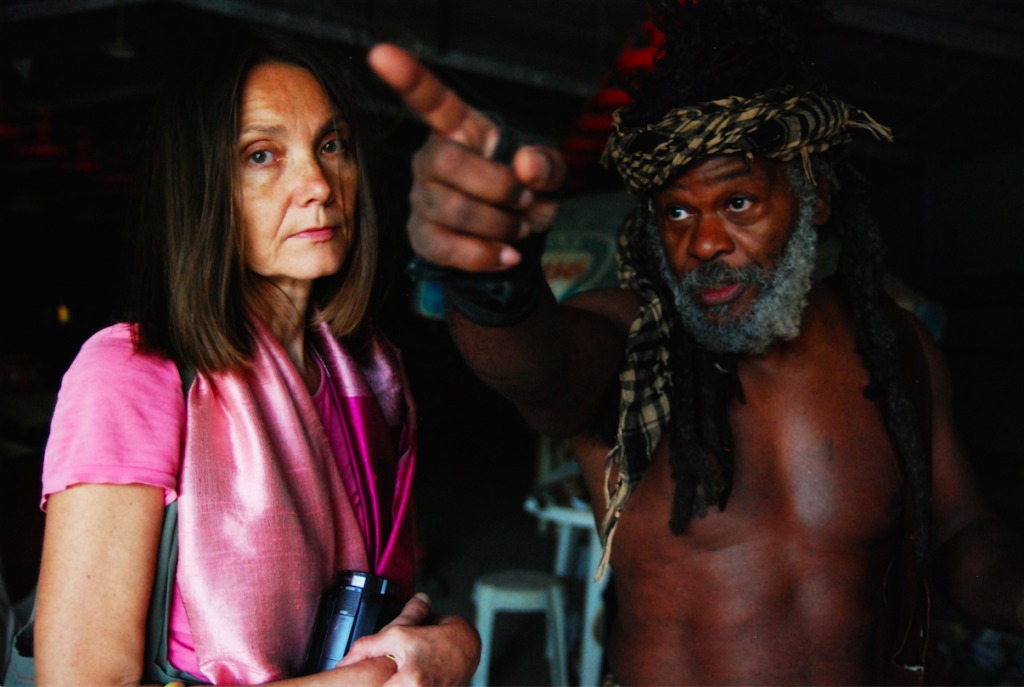
The feast of Katarzyna Kozyra
A conversation with one of Poland’s most famous female artists about faith, food and self-acceptance
The whole thing starts like this. Some two hundred people take their places on slightly elevated platforms in a theatre auditorium. The lights dim; everybody falls silent, and at this point a naked woman ‒ rather small, thin and graceful ‒ stands in front of an ancient harpsichord pretending to play it while classical music is playing from the speakers. Soon the musical piece is over; the woman disappears backstage and then a group of young women wearing uniforms reminiscent of nurses’ whites roll out a huge metal box propped up on a frame with wheels. They take off the lid and reveal a giant figure of an obese naked woman on ice; she appears to be made of a flesh-like material.
View from the performance «Fressen». Сourtesy: Persons Projects. Photo: Magda Typiak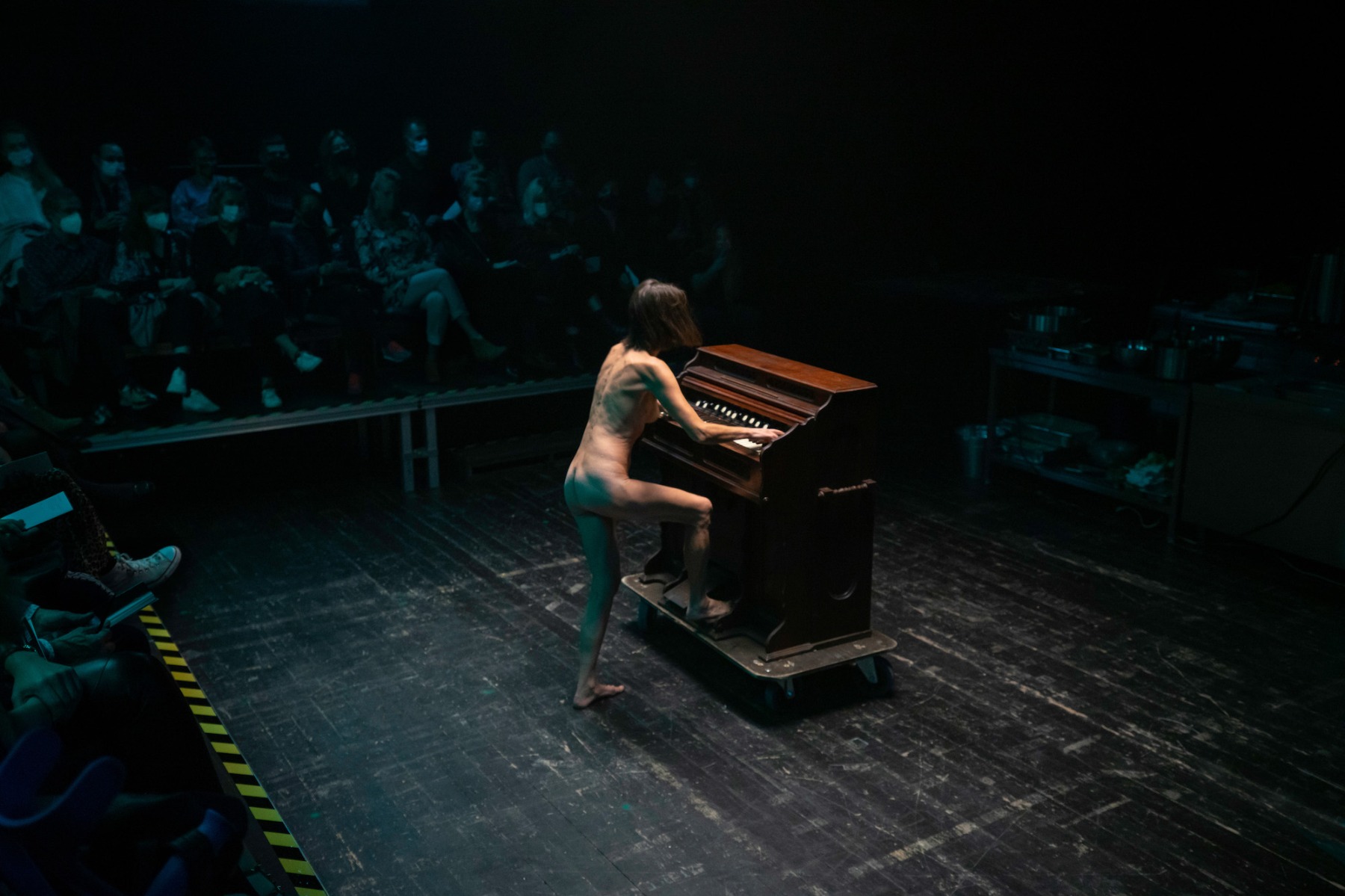
View from the performance «Fressen». Сourtesy: Persons Projects. Photo: Magda Typiak
The ‘nurses’ take their places around her; one of them picks up a surgeon’s scalpel and cuts open one of the thighs of the lying figure’s sizeable thighs, then, with great effort, pulls the edges apart and starts producing fresh fish and prawns from the gaping hole ‒ and then an octopus. The body is cut open in several other places and more seafood is taken out. Meanwhile, the ‘nurses’ have changed their attire and are now sporting chef’s aprons and toques. While they are getting their ‘catch’ out of the body, others take it to the nearby ‘kitchen’ ‒ rows of prepping and cooking surfaces, chopping blocks, electric stoves with saucepans and pots. The octopuses, fish and prawns are now being poached, braised, and fried. The auditorium is filled with intense smells of food and cooking. The cooks are overseen by an energetic small woman with wise brown eyes. It is she who at some point cuts out the face of the figure on ice and peels it off like a mask, revealing the features of a real, living woman. The ‘head chef’ then brings her some freshly cooked prawns; the woman consumes them with apparent appetite. Alongside the kitchen goings-on, a group of men in tacky general/admiral’s uniforms have been huddling around a huge map, moving an object on it every now and then.
View from the performance «Fressen». Сourtesy: Persons Projects. Photo: Magda Typiak
Finally, the living woman who has been imprisoned inside the body on the table gets out and starts to wander among the cooks naked (she is the harpsichord ‘player’ from the opening of the performance), occasionally sampling the content of the steaming pots and sizzling pans. Then, as if she was getting bored by the whole thing, she starts to join members of the audience on the platforms, sitting down by their side; on the first occasion, she chooses someone sitting right next to me. The person on my left is a fifty-something man, and the woman joins him: they exchange greetings and share a joke about something. She goes on to sit down by other people’s side and greets other people in the audience. These people ask her to pose for a selfie; others want that, too. The naked woman always agrees and poses for selfies with apparent pleasure. Meanwhile, the first brave souls from the audience start descending from the viewers’ platforms and walk amidst the kitchen stands; someone tastes the food that is being cooked. Finally large serving dishes with the ready food (prawns, dorado pieces and octopus tentacles) are placed on the body that is covered with a tablecloth or a bedsheet. By now, most of the viewers must have left their seats; they taste the food, taking off their masks to do that (at the time of the performance, Poland’s rates of covid infection were among the lowest in Europe); they greet the woman, exchange hugs with her, pose for selfies with her. The audience is consumed by a kind of happy excitement: the pots are steaming; there is plenty of fresh hot food; we see with our own eyes boundaries being pushed (between art and life; between watching from afar and being able to touch and even eat; between the reality of the pandemic and our instinctive desire to forget about it ‒ if only for a while); there is an increasing sense that ‘everything is possible’. The naked woman wanders among the people who carry on taking selfies or posing for pictures with her. The nudity of the woman seems so natural, and it is her easy manner that removes all boundaries, becomes a key that opens every lock. A couple asks a photographer to take a picture: they stand next to the woman and strip ‒ down to a bra ‒ for a few seconds. And now everybody is invited to a restaurant where the food will be taken and where the feast will go on...
‘Feast’ is not a random word here. The event I am describing is a recent performance by Katarzyna Kozyra called ‘Fressen’, an allusion to a significant occasion in the history of Polish-German relations ‒ the wedding of the Polish princess Jadwiga Jagiellonka and Duke of Bavaria George the Rich (Georg der Reiche) in 1475. Said event is considered as the grandest feast in the history of the Middle Ages.
View from the performance «Fressen». Сourtesy: Persons Projects. Photo: Magda Typiak
According to the press release, ‘Katarzyna Kozyra touches upon the theme of food and its origin, which is particularly important in today’s light. Food has always played an important role in our social and cultural life as well as being a theme in art since ancient times. It has been an ever-present subject in still life paintings from how it’s prepared to how it’s consumed. This project parallels the artist’s interest in the subject of the human body, obesity, and gluttony, which have already been seen in her earlier works such as “Women are Waiting” or “Diva. Reincarnation”’.
View from the performance «Fressen». Сourtesy: Persons Projects. Photo: Magda Typiak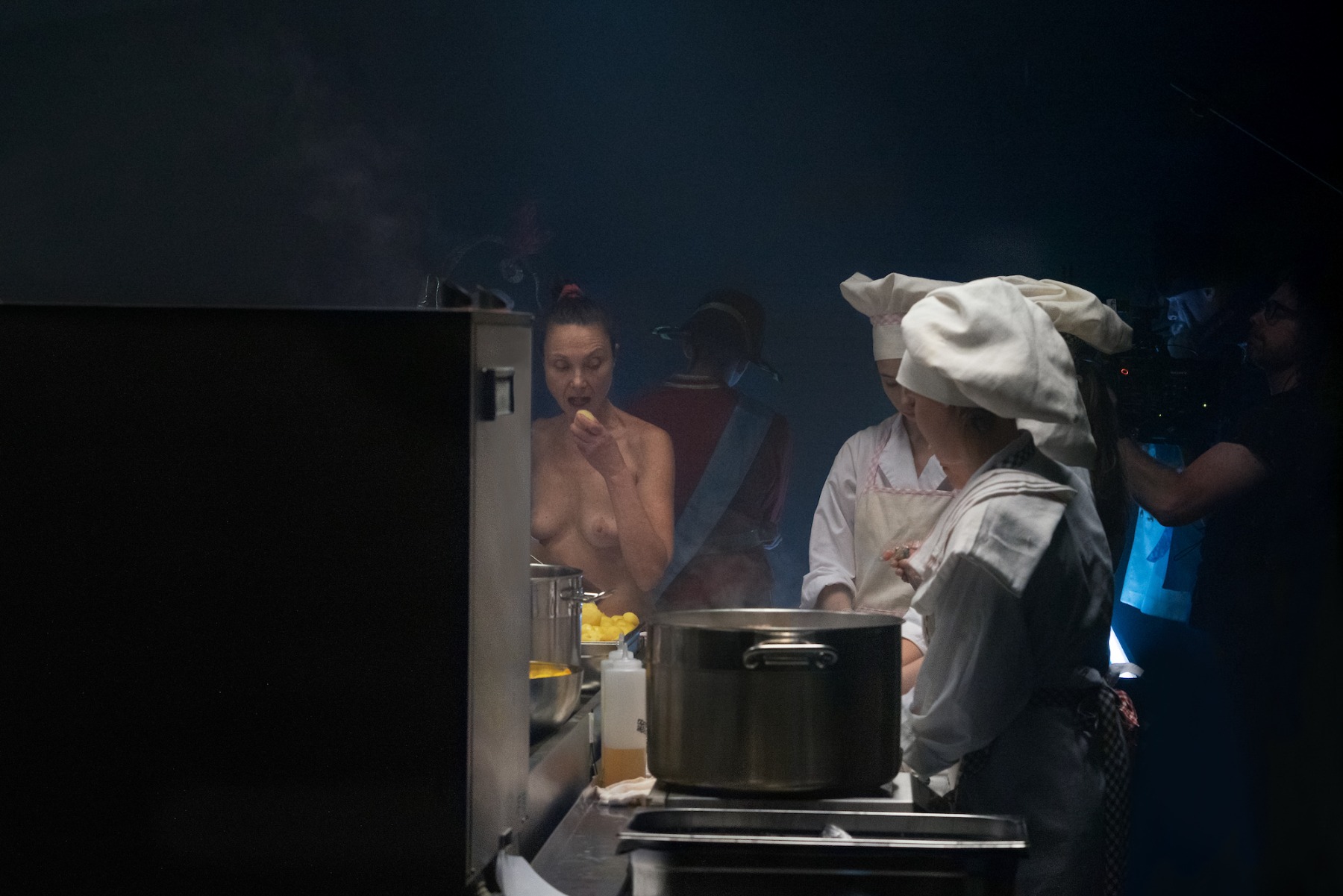
The thin graceful naked performer that I mentioned ‒ that was Katarzyna. Born in 1963 in Warsaw, as a child she spent quite a lot of time in Munich where her father worked as a trade representative of Poland. ‘He and I are very different and yet we do share some common traits: we both have achieved some things in our life; we both have established ourselves in our own ways’, Katarzyna tells me when we are sitting next to each other at a dinner party (feasts tend to overlap and merge into each other) hosted by the Gunia Nowik Gallery (one of the organisers of the performance) on the following day. All of this is taking place during the Warsaw Gallery Weekend, a programme traditionally held in October (this year, among other events, featuring the ‘Fressen’ performance). The Polish-German theme is not just about Katarzyna’s childhood: she also completed a post-graduate course in Germany at the Leipzig Hochschule für Graphik und Buchkunst in 1998, after graduating from the Warsaw Academy of Fine Arts.
In the 1990s she became well known in Poland as a prominent representative of the so-called critical art (a movement that cannot also be imagined without Artur Żmijewski and Paweł Althamer). From the get-go of her artistic career, Katarzyna was famous for breaking social taboos like nudity, old age and death ‒ for which she has frequently been attacked by Polish conservative circles.
It started with her ‘Pyramid of Animals’ (1993), an installation using the visual theme of the Town Musicians of Bremen and taxidermized bodies of animals killed especially for her work, thus raising the question of man’s right to kill ‘our lesser brothers’, a right constantly justified on pragmatic grounds. Revulsion was also a widespread public reaction to her ‘Olympia’ (1996), a photography triptych and a video that referred to the famous painting by Manet. It saw Katarzyna capture herself in the exact ‘Olympian’ posture following a course of chemotherapy treatment (in 1992 she was diagnosed with cancer) ‒ bald after losing her hair, her tortured body exposed. It was her way of demonstrating a break with the social stereotypes of female attractiveness and norms of ignoring or rejecting ‘uncomfortable’ subjects.
Olympia. Photographic installation. 1996
In 1999, Katarzyna Kozyra represented Poland at the Venice Biennale with her “Men’s Bathhouse’. For the purposes of shooting the footage for the video installation, she visited a men’s bathhouse in Budapest wearing a fake beard, a silicone penis and a towel covering her breasts. In 2003 Katarzyna started working on a series of performances and videos entitled ‘In Art Dreams Come True’, one of the pieces of which (the ‘Diva. Reincarnation’ project performed at Warsaw’s Centre for Contemporary Art at Ujazdowski Castle and the Barbican Gallery in London) saw her appear in a metal cage while also encased in a fake body, a shell replicating the figure of a fat naked opera singer – a costume that made it extremely difficult to sing.
In 2012, Katarzyna started working on a project called ‘Looking for Jesus’, where she dealt with the subject of religious faith and explored the so-called Jerusalem syndrome, a condition that makes people see themselves as prophets and messiahs in full seriousness. The first video of the series was shown a year later. In the same year the artist launched her Katarzyna Kozyra Foundation, ‘which stands out from other foundations dealing with contemporary art by focusing its activities on supporting women’s activity in the field of culture and art’.
One of the most recent of her key projects ‒ ‘A Dream of Linnaeus’ Daughter’ (2018), comprising two photography series and a video made in Carl Linnaeus’ garden in Uppsala ‒ is dedicated to a real person, Elisabeth Christina von Linné, one of the scientist’s five daughters who dreamt about making a career in science and carrying on her father’s work but never went to university. Here, according to the Polish art critic Karol Sienkiewicz, ‘Elisabeth conducts a choir in which Beethoven’s famous “Ode to Joy” is sung by a dog, a donkey, a cow, a horse, a goat and a monkey. The animals moo, squeak and hum in the rhythm of the EU anthem, standing on palettes, which symbolize Noah’s Ark. Kozyra’s video presents a new world order that levels all differences, deeming all creatures equal.’
I reviewed all these key moments in Katarzyna’s artistic career studying the materials in my hotel room in Warsaw as I was preparing for our conversation at her home, in a small private house with a garden in the Mokotów neighbourhood, nearby a local park. I must confess that, having mixed up the Warsaw and Riga local times, I arrived an hour early, but Katarzyna took it in her stride. We had a nice quiet conversation in her kitchen over a cup of coffee as well as some pâtés and cheeses brought over by her fellow performer Justyna, a professional chef with a film critic’s degree. It was Justyna who cut out ‘Fatty’s’ face and then fed Katarzyna, who was lying in the sarcophagus of the body, some freshly poached prawns.
View from the performance «Fressen». Сourtesy: Persons Projects. Photo: Magda Typiak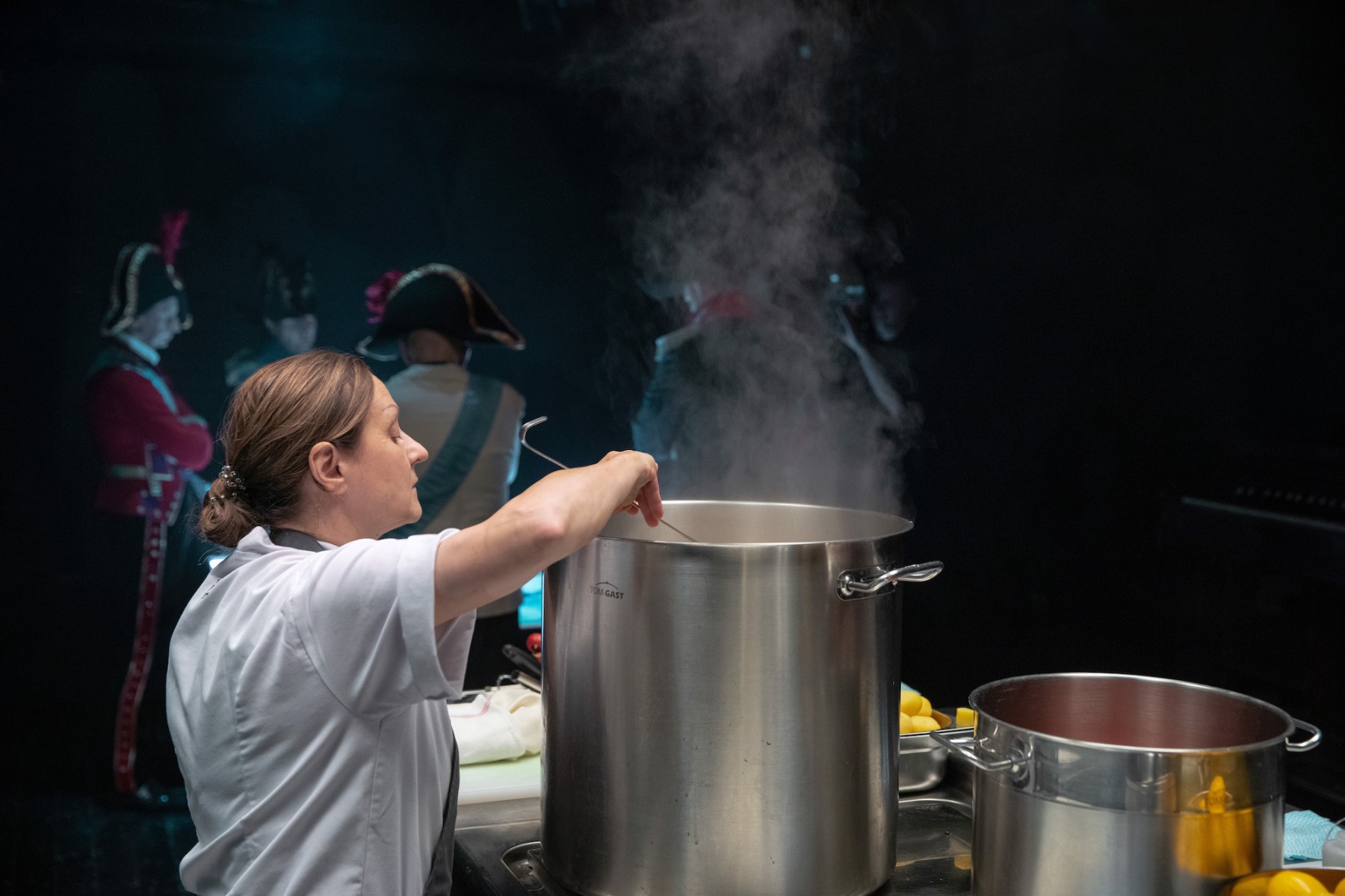
When I was watching you during the performance, you seemed so surprisingly calm and confident ‒ as if you were floating effortlessly through the proceedings...
Thank you!
Did you really feel like that at the moment or was it just you being professional ‒ being able to look like that, never betraying the anxiety inside?
I should mention at this point that I have previously done something similar in my ‘I Art Dreams Come True’ series: ‘Cheerleader’, ‘Diva’, ‘Castrato’, ‘Incarnation’… It was the greatest nightmare of my life, because I had never done anything like that before – I had never performed in front of public. I actually forced myself to do all those things. And now, after six years of similar torment and forcing myself to do things, I discovered the other day during this fucking performance that I suddenly don’t give a shit anymore; I have overcome it, I have learnt. Because I had for such a long time been practicing this skill of being ok with not being perfect in front of the public ‒ of swallowing my shame, the indolence, the lack of self-confidence. I was practicing not having to be perfect because it was not really me. And the effort finally brought fruit during the performance the day before yesterday. Before that, with the exception of a performance in Uppsala three years ago, I had not done anything of this sort for over a decade. So it was a kind of discovery for me: I can do this!
Also, at some point during the performance, someone from my team told me that energy levels in the audience were dropping ‒ that we should do something about it. And I said ‒ fine, I’ll think of something. And I thought that the perfect thing to do would be just to...
View from the performance «Fressen». Сourtesy: Persons Projects. Photo: Magda Typiak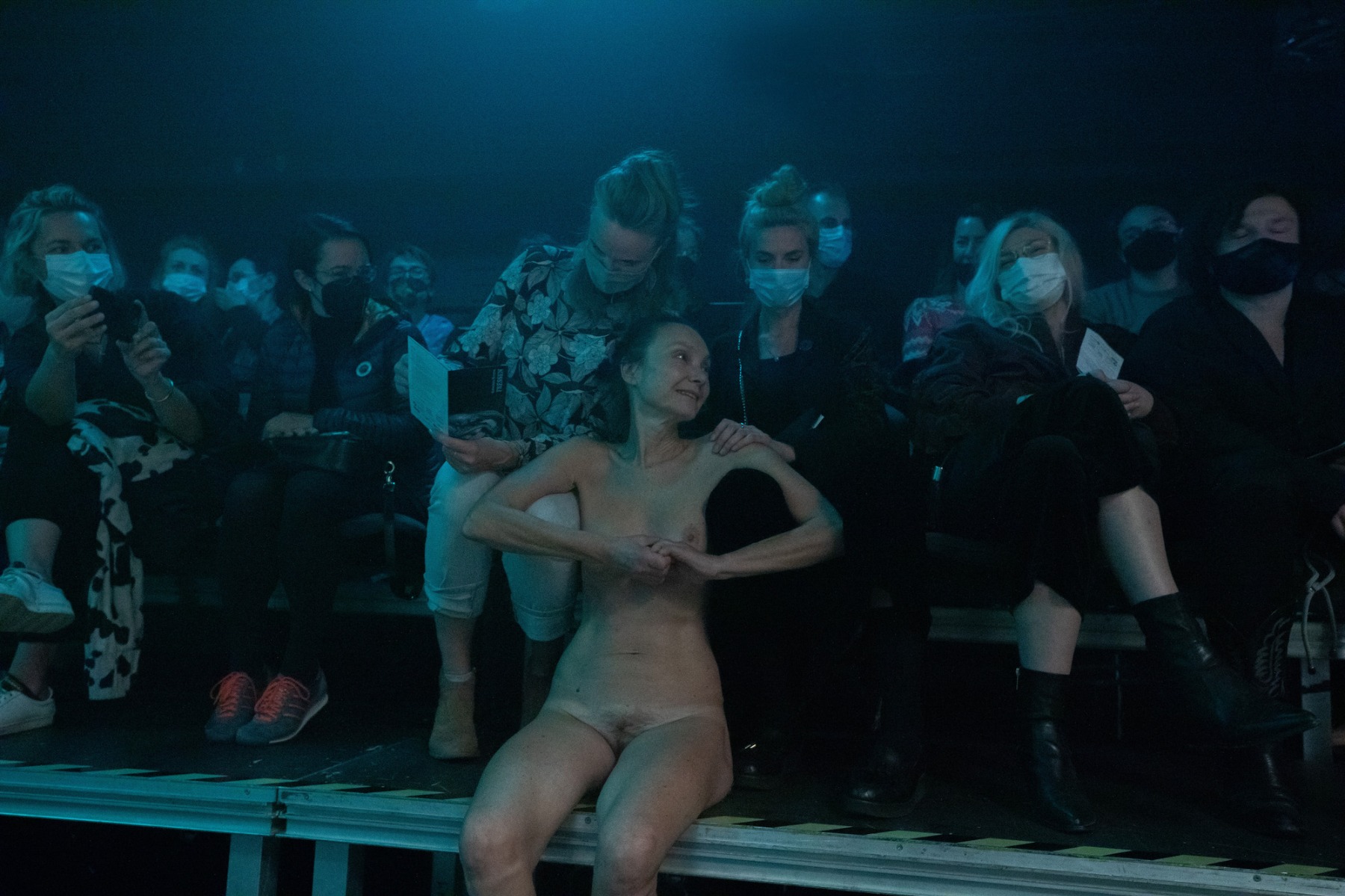
Make contact?
Just to make contact, yes. Half of the people in the audience were my friends anyway. And I know very well how I look, and everybody else also knows, because there was for instance, ‘Olympia’ before that. And I felt that there was a very good response from the audience. People asked if they could take selfies with me. Because of this response I felt that it was the right way. So I proceeded to develop the situation further. And some people in the public felt that if I approached them, it meant they could approach me ‒ and they started coming down from the viewers’ platforms. They started approaching and checking the pots and saucepans. Then other people joined in, and the whole situation evolved into a whole lot of fun. The audience started to consume the performance in a totally different way. And also it was all being recorded by the cameras above us and all these selfies that people were taking with me were also recorded by our cameras above our heads. (Laughs) So it was already the next level of consumption, of being consumed.
This part of the performance was complete improv, right?
Yes, the second part was totally spontaneous.
Was there a plan for the finale?
There was no plan.
There was no plan? You mean that you knew how you would start it but were prepared to proceed depending on what your intuition would prompt?
Nobody knew how it would work. Many people thought that it would be unbearable for the audience to watch things getting cooked for an hour and half. And it was unclear how many times I would be able to get out of the body and then get back inside. Meanwhile, others thought that people in Poland today were so interested in cooking and gastronomy that no-one would find it boring. But when I was told during the performance that energy levels were dropping, I had to bring it back. And that is what actually happened.
Initially we also thought that it would only be the girls of our on-stage team who helped prepare all the fish and seafood that would eventually taste and see what the results of all the cooking were like. And the food, once it was cooked, would be taken to a restaurant were all the people from the audience would be invited for a tasting. But then I thought ‒ why don’t we let the public sample the food right there, on the spot? And that is how it happened. The whole thing developed by itself!
View from the performance «Fressen». Сourtesy: Persons Projects. Photo: Magda Typiak
But what was the group of men in uniforms of old-time generals or admirals standing apart from the cooks and the stoves all about? They were crowding around a map of sorts…
They were playing with tiny models, replicas of actual warships from the First World War. They were… ruling the world, let’s say! (Laughs)
Why did you need them?
As a counterpoint to the cooking performance. Because everything was happening at a great speed, at high energy on the cooking front. Whereas they had to consider things… then shift something… then think again. I needed a counterpoint to this female, corporeal, substantial world.
View from the performance «Fressen». Сourtesy: Persons Projects. Photo: Magda Typiak
The material world…
Yes, material. Whereas here we had a world…
…of weird ideas!
Yes, a world of useless ideas!
View from the performance «Fressen». Сourtesy: Persons Projects. Photo: Magda Typiak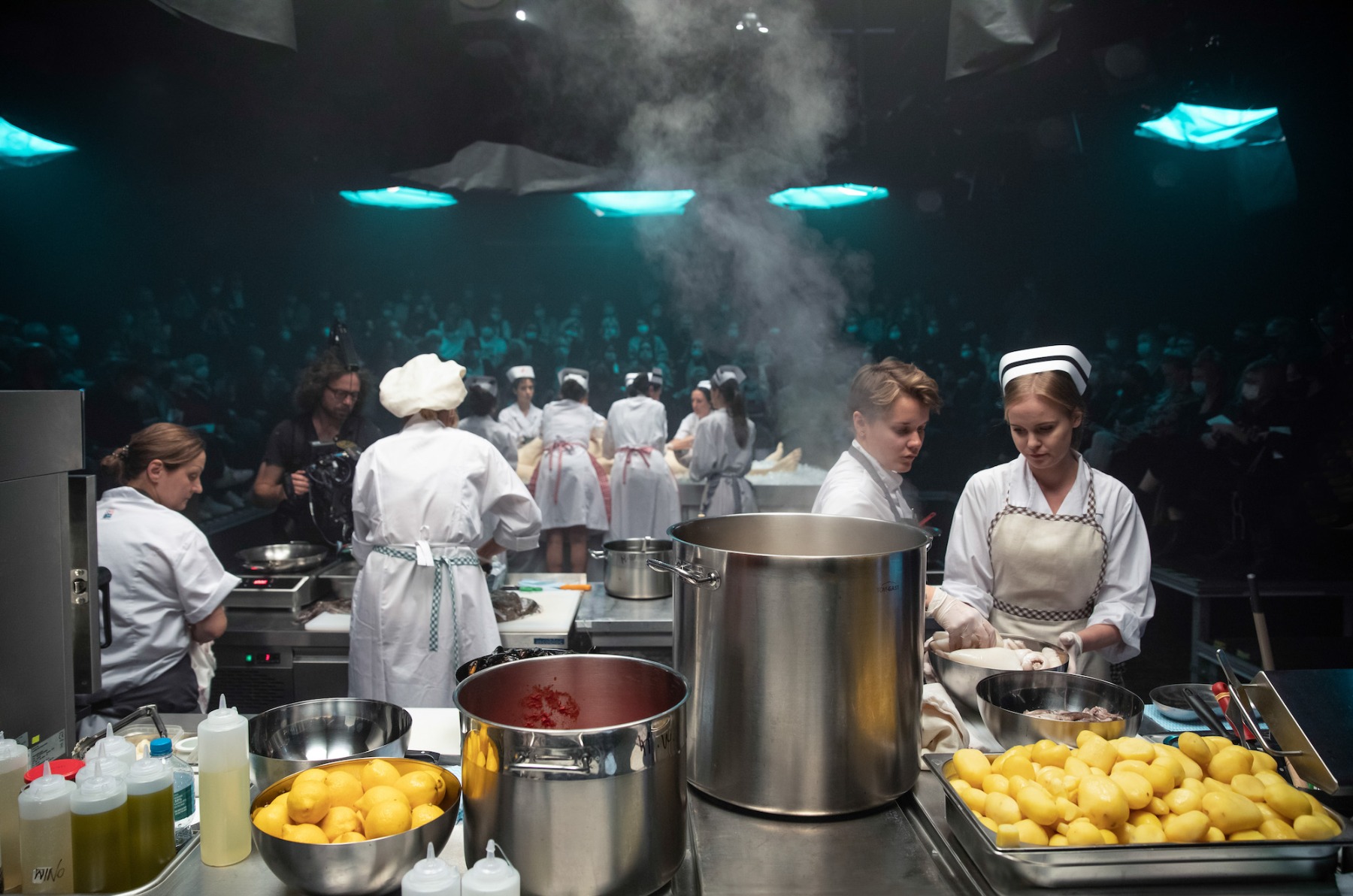
And it also was in a way a reference to Rembrandt’s ‘Anatomy Lesson’. The viewers were even provided with sheets of paper and pencils at the entrance so they could take notes ‒ like medical students at an anatomy theatre. Was the idea of visually reimagining Rembrandt the point of departure for the project?
No, it actually started with two films I saw in the 90s that made a huge impact on me. One was Fellini’s ‘And the Ship Sails On’. Pina Bausch plays a princess in it, and she has a brother, a prince, who is about to ascend the throne very soon. And he is like a huge child with a baby’s voice… this enormous body that speaks in a really childlike voice ‒ I was fascinated by this idea. The other one was a film by Liliana Cavani ‘La Pelle’, ‘Skin’, based on the eponymous novel by Curzio Malaparte. It is about [Naples] after its liberation by the allies. And there was a lot of really horrific stuff going on, like mothers selling their young children, their sons, to paedophiles and suchlike. At some point something incredible happens ‒ they have caught a siren, a wonderful creature straight from the depths of the sea. And what do they do with this siren? They cook it and they eat it. That’s all they can do with this wondrous innocent creature ‒ consume it, that’s all. So this idea lived somewhere inside me for many years and suddenly and unexpectedly materialised as a performance.
View from the performance «Fressen». Сourtesy: Persons Projects. Photo: Magda Typiak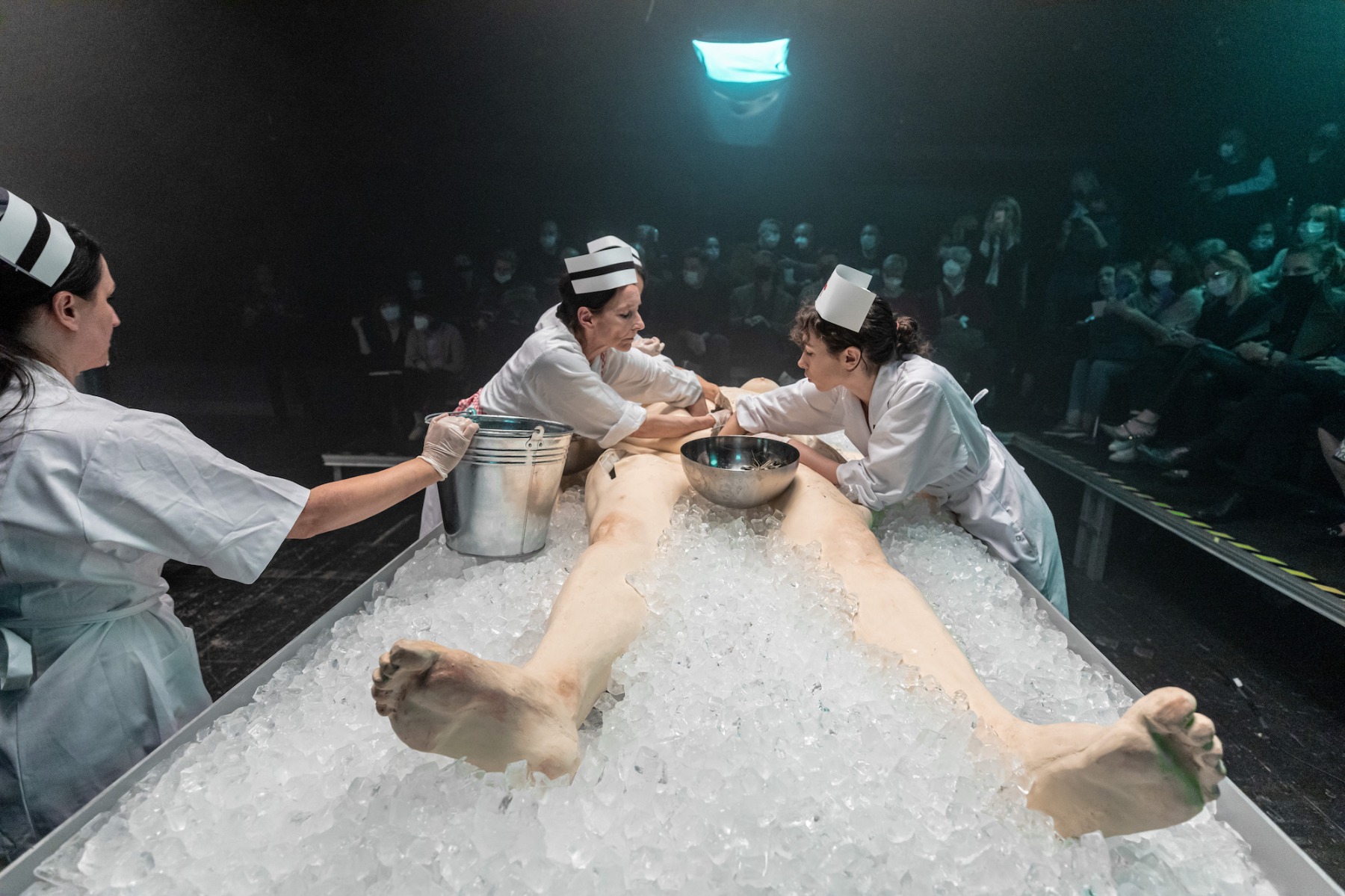
So it was an attack on consumerism? I would not say that the audience saw it quite like that.
The initial idea was that only my closest people would be present, those who share my everyday life. That is why the girls from my foundation, my husband Fabio (Fabio Cavalucci, an internationally well-known curator ‒ Author’s note) and my best friends were all there… Because the idea was that everybody would take a piece of me, that my closest and dearest people would consume me. And through the things that I do and things that I think I also constantly consume myself. That was the original intent. Not everybody in the audience knew that the people in front of them were my friends and loved ones. But that was very important for me. I knew it would make it work.
And today, as I review in my mind what actually happened, I even feel a bit shocked. The public is consuming the artist, you know… And the artist is giving herself freely. But so many different interpretations of the performance have already appeared. And women tended to read it absolutely differently than men. Incredible! Men thought that the everyday life of women was elevated here to the niveau of males who were doing all sorts of very important thinking, planning, directing. And the way female viewers saw it, there were these little boys posing in funny hats and very colourful costumes who had to look impressive.
View from the performance «Fressen». Сourtesy: Persons Projects. Photo: Magda Typiak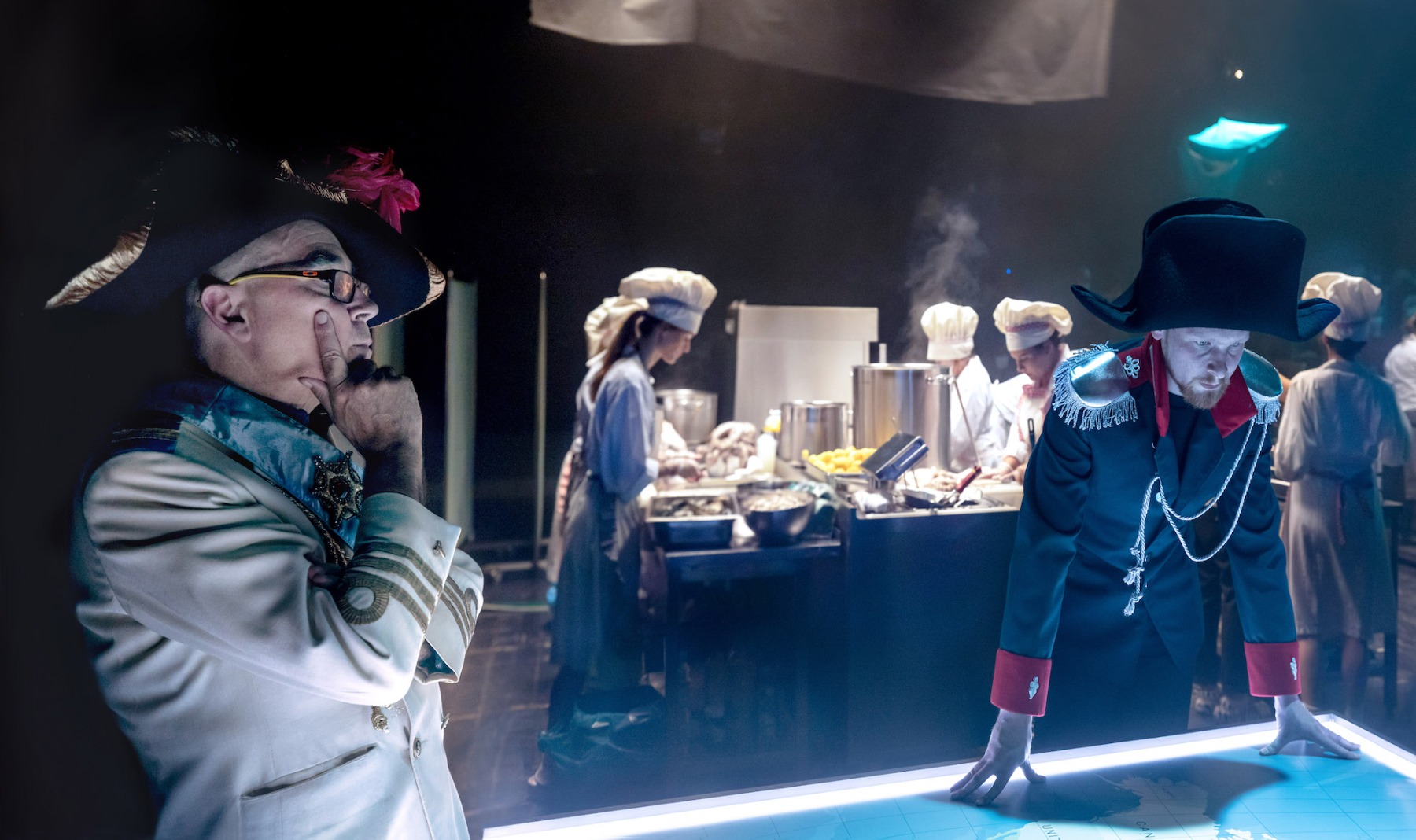
For me it was a kind of post-covid happening where suddenly all the social distancing stuff faded out and everything was possible ‒ you could touch, you could taste...
Pick up with your own hands…
And there were no boundaries anymore... No line between the audience and the performer. Everything is possible. Another thing I wanted to ask you: your nudity ‒ was it a reference to the subject of body as a costume?
No, no. This Big Fatty was really myself. And she was revealed, without any clothes on. And that is why my other alter ego ‒ myself, alive ‒ also had to be naked.
It was really obvious. Because I was thinking in the beginning ‒ how the fuck I should be dressed? We tried out a number of versions but nothing seemed quite right.
And the rest of the people, everybody around me, had to be fully dressed and wear uniforms. I told the other performers: ‘You must imagine that you are all part of my dream. Don’t pay any attention to what I do, to me walking around and watching you do things. You are all in my dream.’
But speaking of the roots of the concept ‒ I don’t even know if there is any need for that. Because there are already so many interpretations. And I like it. I like what you said as well. This closeness, this flesh, this meal where flesh is consuming flesh.
View from the performance «Fressen». Сourtesy: Persons Projects. Photo: Magda Typiak
By the end of it, it almost felt to me as if you were the one who was dressed and the rest of us were naked!
(Both laugh) Yes!
Because you acted so natural…
Perhaps it’s a good idea for my next performance: I will convince the public to take off all this unnecessary shit. To achieve that, I will have to make it very, very hot inside the theatre. And they will have no choice but to take their clothes off.
Incidentally, in your ‘Looking for Jesus’ video there is already a reference to an operating or anatomy theatre. One of the characters mentions it.
Yes, that’s true. And that is why the audience were asked to take notes, because these people were like spectators in an anatomy theatre.
Perhaps that is why you chose seafood? After all, these objects do remind of the internal organs of a human body.
Yes, of course. And it is all about the body, the flesh, the organs. Because all flesh has emerged from the oceans. We have all emerged from the oceans, thanks to evolution. And now one flesh consumes another.
View from the performance «Fressen». Сourtesy: Persons Projects. Photo: Magda Typiak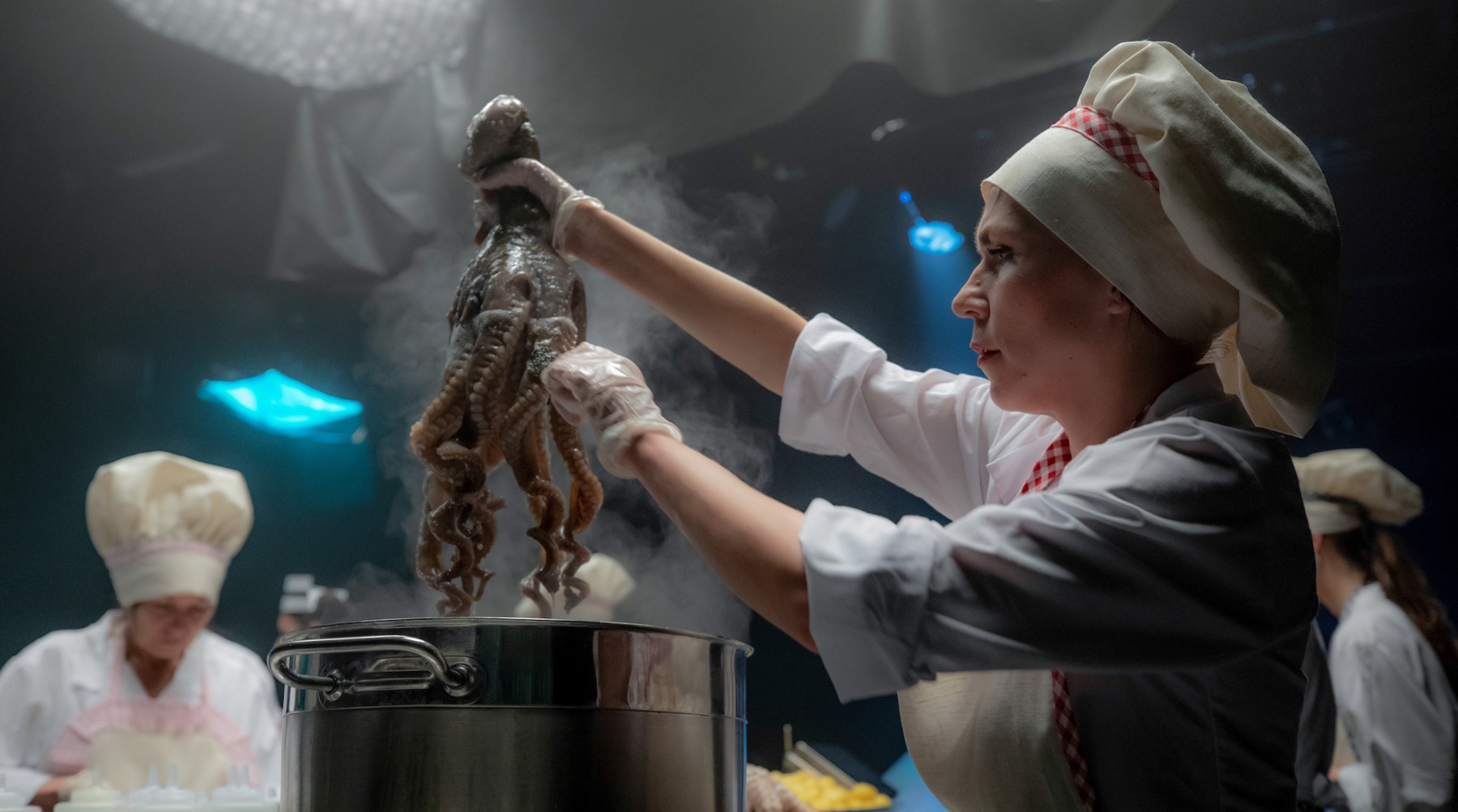
But who is this Fatty?
It’s me.
But why in this shape exactly…
So fat? It is about the proto-woman, the giver, the sharer… The Venus of Willendorf was also a fucking fatty.
But it’s not the first time when you are using Fatty in your projects?
No, no, it first appeared in ‘Diva. Reincarnation’. But she was much bigger this time around.
It is a different you, then.
Yes!
View from the performance «Fressen». Сourtesy: Persons Projects. Photo: Magda Typiak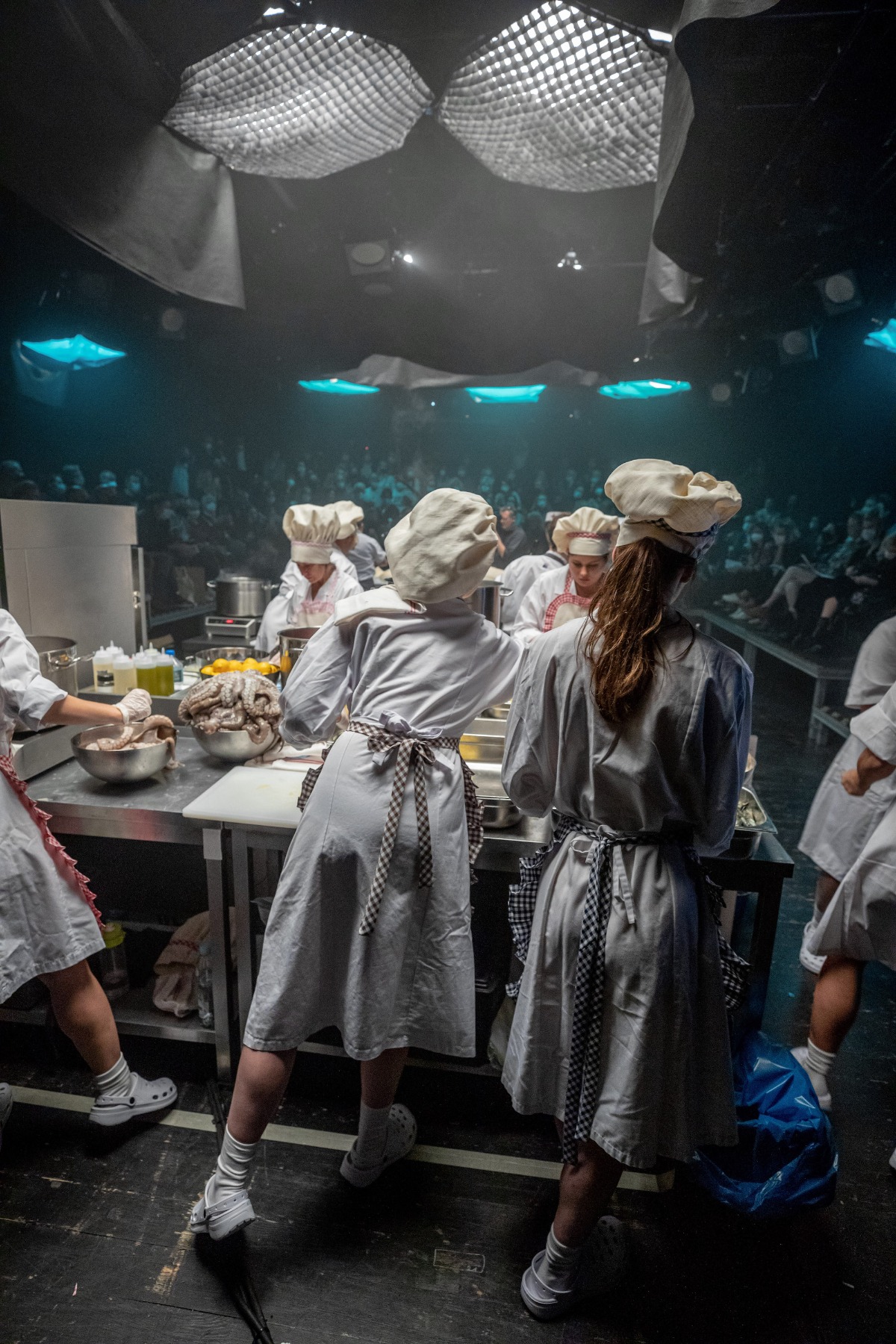
How do you perceive your body? Do you feel comfortable inside it?
Back in the day, I never felt comfortable with my body. But the older I get, the more comfortable I really feel. When I was young, I had all these problems that teenagers have – anorexia, bulimia, everything. There was always something completely wrong or not good enough. And after I got ill with this Hodgkin’s disease, I started to be more open to it – to the ways it changes. It’s really interesting to see how things constantly in motion, you know.
Like a project under development, in the middle of a process!
Yes, yes, a process. And then I had this accident – I fell from a tree and broke my leg in three places. And I’m so happy that I’m functioning again, that I can walk and do everything. So how could I not accept it if I’m so happy that it functions? I had to overcome all this body shame and shame of not being perfect. It was a very long process and a big work to do.
But during your career you have also been transforming yourself for your projects. For your video work ‘Men’s Bathhouse’, presented at the Venice Biennale in 1999, you were wearing a silicone penis, pretending to be a man.
It was really a total nightmare because I felt naked anyway. It didn’t feel like the penis was hiding me or something… I felt absolutely naked among actual men. And they were also much bigger and much stronger! (Both laugh) So it was really a total hardcore. It was the opposite to what I wanted to achieve.
Katarzyna Kozyra in a video work «Men’s Bath». A still from the video. From Zachęta – National Gallery of Art collection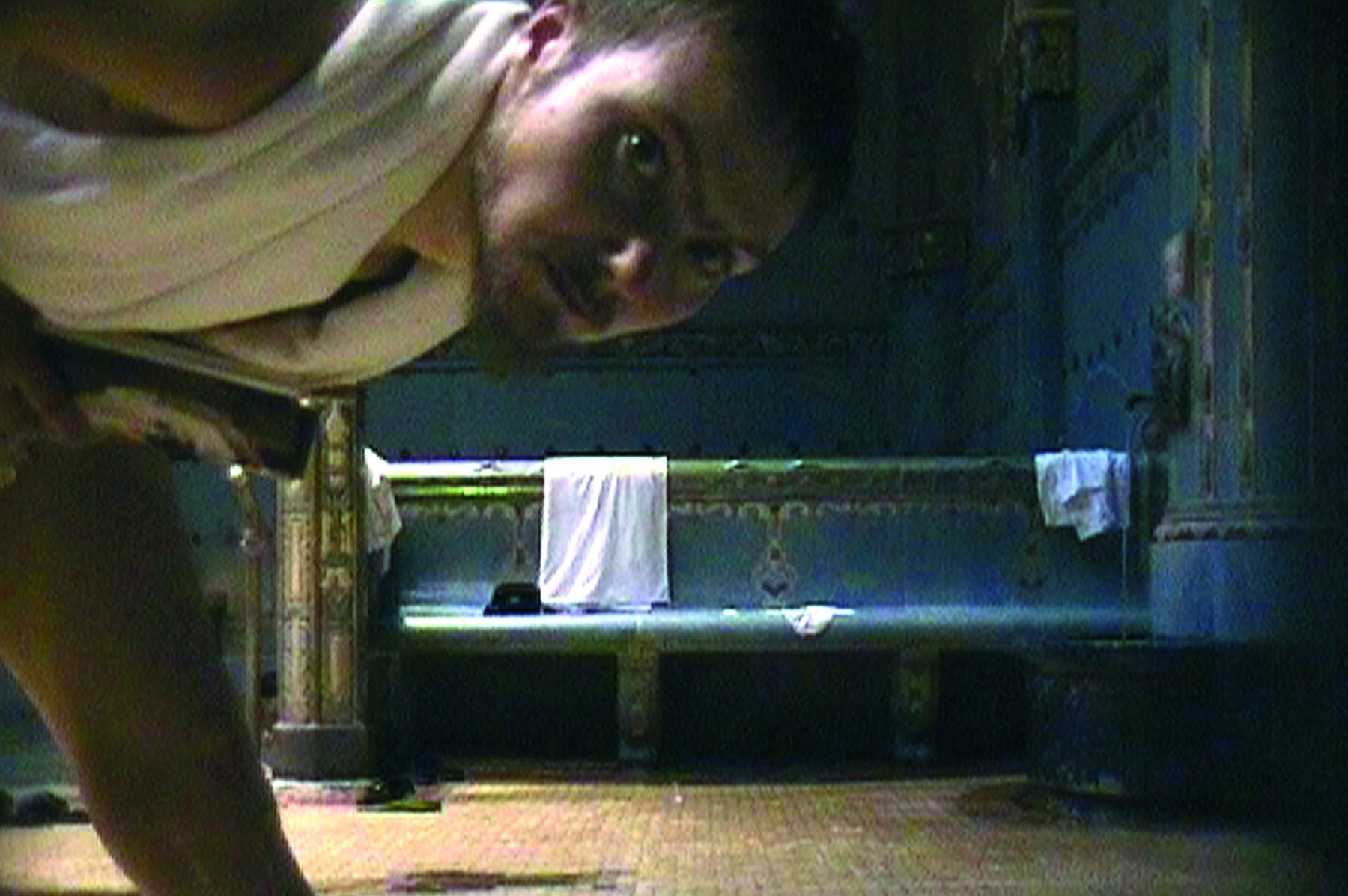
You filmed it in Budapest, right? I think I have visited the bathhouse…
Yes, they had separate sections for women and men. The women’s section was quite nice but nothing special. The men’s one was decorated with all these sirens and Plutos.
When you were making the video, did you do much editing at the final stages?
No, I just discarded whatever did not feel particularly necessary. I kept everything where anything was going on. The parts were nothing really happened and where there was no-one there, I threw those away.
Whereas, if I’m not mistaken, you had a lot to do while editing ‘Looking for Jesus’? You had about a hundred hours’ worth of raw footage...
I am still working on that. I have a friend who works with me on that when I have some time. It is quite difficult to sit and listen to various conversations for 3‒4 hours on end. The subjects are changing all the time, and so on. It is a bit like working on a news report or an interview. You have to throw away the shit and to condense what you think is the meaning.
How did you arrive at this idea of exploring the subject of the Jerusalem syndrome and ‘prophets among us’?
In a way, it is a sequel to ‘In Art Dreams Come True’. Pretending versus really being something. I wanted to find people who were not pretending, who were really being what they were preaching. Whether it is Moses that they consider themselves to be or a witness to the Apocalypse, they genuinely believe in it ‒ they think it is a gift that God has given them. I found it very intriguing.
Which of the prophets did you find the most impressive?
The problem is that they are all very intense and each of them has their own idea, completely different from others. I felt that whoever I was working with at any given point was the most interesting one. It is only now, at the editing stage, that many things become clear for me. Because I have a whole background of similar stories inside me and I can compare them.
From the project «Looking for Jesus». Photo: Kasia Szumska
To me, ‘Looking for Jesus’ is also a story of how we reproduce religious rituals for millennia on end. And our spiritual experience appears largely formatted for this reason. I was very moved by you yelling ‘Jesus, Jesus, wait!’ after a ‘prophet’ who was disappearing around the corner. Somehow it was all so real... Even though he was a fake prophet. But religion is impossible without our faith. And if you believe that Jesus is right here, in our midst, miracles start to happen...
Yes, yes, of course!
Does religion play a role in your own life?
No... I do have something like a faith of my own, but I am totally indifferent to all these rituals. Particularly in Poland, where, I believe, they have transformed into some mechanic bullshit. But I attended several masses in Jerusalem, and I must say that I was really, really moved by this experience. It was at 5 or 6 in the morning in the Church of the Holy Sepulchre: 50 or so people of various nationalities had gathered for the German-language mass. And there was this sense of total community. I really was crying. I can understand that. This need to feel united. Whereas here… Here the rituals achieve the opposite: they kill everything; they do the opposite: they kill the spirit.
But you do believe in something bigger than us, in a certain higher power?
I believe that we are just part of this very big and very complicated yet very simple mechanism… like the Universe or something. And I’m happy with this. And it’s enough for me. I feel that I am a part of something. And believing in this makes me happy, really.
View from the project «A Dream of Linnaeus' Daughter» (2018). Photo: Kasia Szumska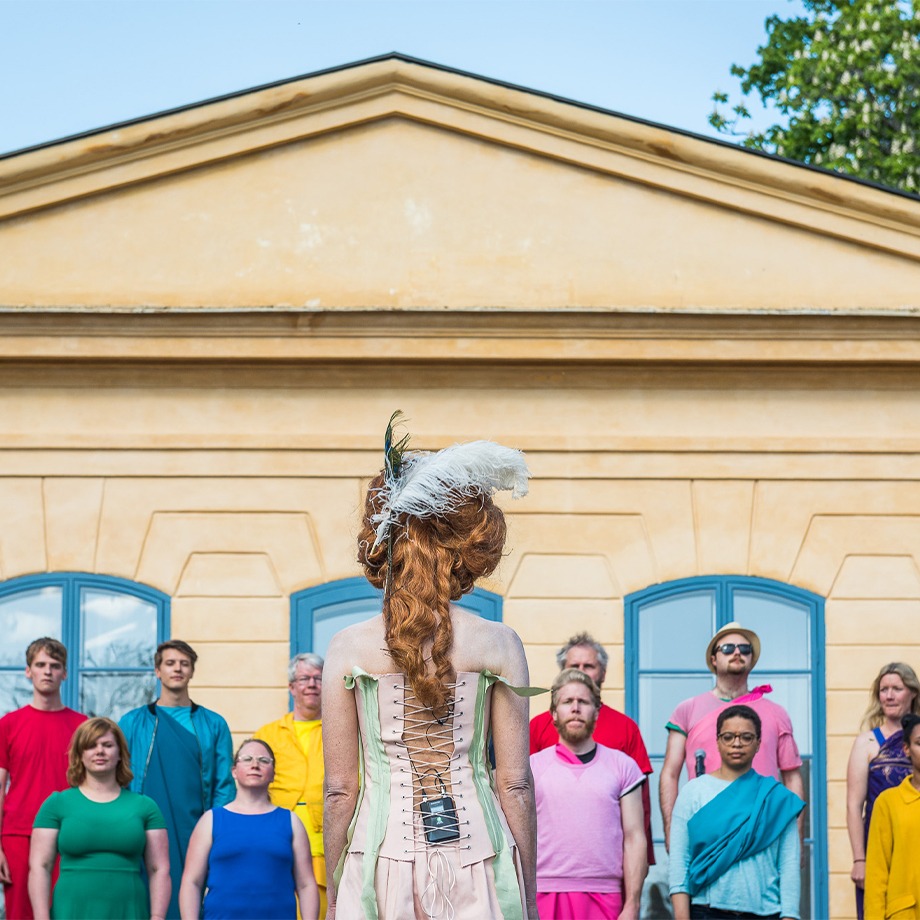
Did you touch upon this subject of unity in your project ‘A Dream of Linnaeus’ Daughter’, where you oppose the traditional system of dividing living beings into higher and lower ones?
Yes, among other things. The whole thing started with an invitation to stage a performance in Uppsala. Now, Linnaeus lived in Uppsala and it was he who came up with this classification, this division of all the living creatures into species and subspecies. He had a daughter, and the daughter was a smart one; she did her own botanical research but was not allowed to study at the university, because Linnaeus, her father, was a fucking conservative, and so was her mother. Linnaeus had not one but several daughters and a son ‒ perhaps not really an idiot but also obviously not a very bright man. And Linnaeus, of course, left all his life’s work not to his daughters but to his only son, choosing him as his successor. And the whole thing totally collapsed.
What I also had in mind was the story of Noah and his animals, because I was still under the influence of the story with the multiple Jesuses. Plus, the addition of the European Union, which perhaps may be approaching its conclusion. All these things merged together in this work.
It is not just in your projects that you focus on woman’s role in the society; you have also created your own foundation that supports contemporary female artists and rescue from oblivion their predecessors. How long has it been operating?
I think it was in 2012 that we opened it. So 8‒9 years. It is a good enterprise because you can achieve things that can never be achieved by institutions due to the fact that they must plan everything a long time ahead. And there is a gap that we fill. There are studies of the presence and role of women in art academies. And there are special shows, for instance, an exhibition of works by Urszula Broll whose name was indeed almost half-forgotten. We also prepared for the show a huge catalogue. And the show gave rise to huge interest in her legacy. Now she is represented on the Polish art scene. Of course, the foundation also sustains me, it helps me not get swept under the carpet. And I think that the activities of the foundation are also important for the general public as a whole, not just for the female part of it.
How do you feel as an artist who has devoted so much time and energy to openness in views on the human body, on relationships, in the Poland of today?
It’s a very sad joke ‒ that things that are going on here. But I also believe that it is really cementing people together now in trying to not let important cultural or educational things disappear. A lot of private money is involved now in trying to save these things. I hope that sooner or later ‘they’ will go and maybe the society will be more united after that… But it also means that the previous leaders were too selfish.
Final episode of the performance «Fressen». Photo: Sergej Timofejev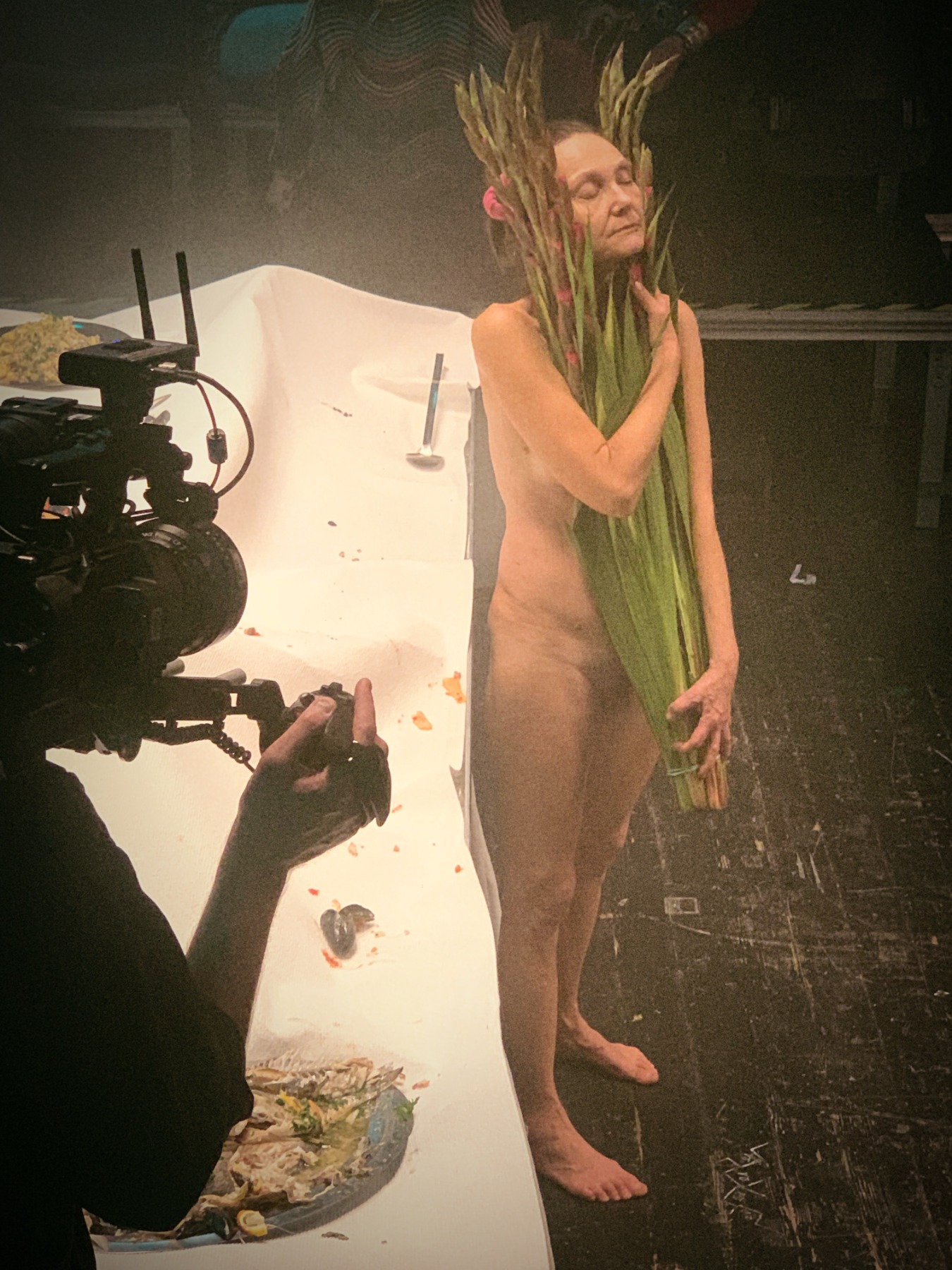
I was struck by the words of your colleague, the curator Asia Tsisar, when she said that ‘10 years ago, the theme of Katarzyna Kozyra’s work was treated as a provocation; today it is seen as a taboo’. I, too, witnessed the 90s and the feeling that we are moving toward some kind of general openness. But it never really came to anything... Do you think that it is because of the selfishness of the previous leaders?
Yes, I do. I can imagine that it may be a wonderful feeling for someone to possess that sort of power but the thought of pulling strings for me is disgusting really. And all the money shit, and all the new technologies ‒ Facebook, Google – that may be perfected simply for gaining more power...
Do you think that your role as an artist has changed over the last ten or fifteen years in comparison with the 90s, for example?
No. I think that my role has always been the same.
And what does it comprise?
It is hard to put into words. To express or to make something visible, to make something alive that is there anyway, present yet not seen because it has been drowned under a lot of shit. You have to take it… get it out of this mess...
Like that octopus!
Like the octopus! Yes… (Both laugh).
